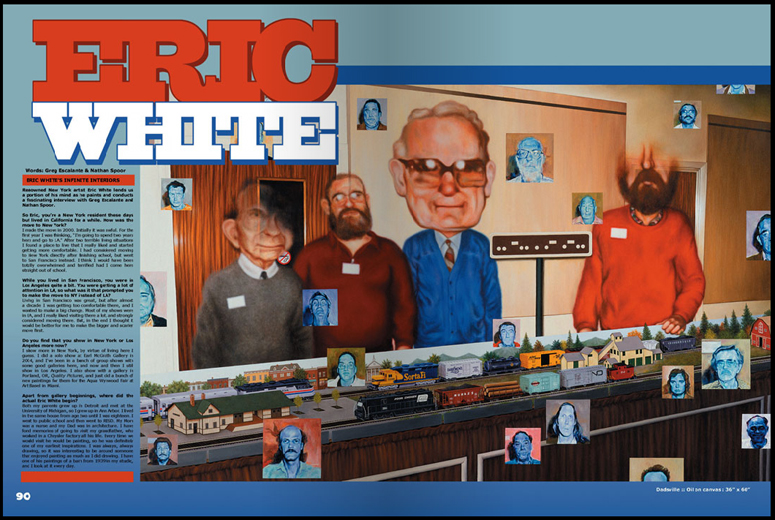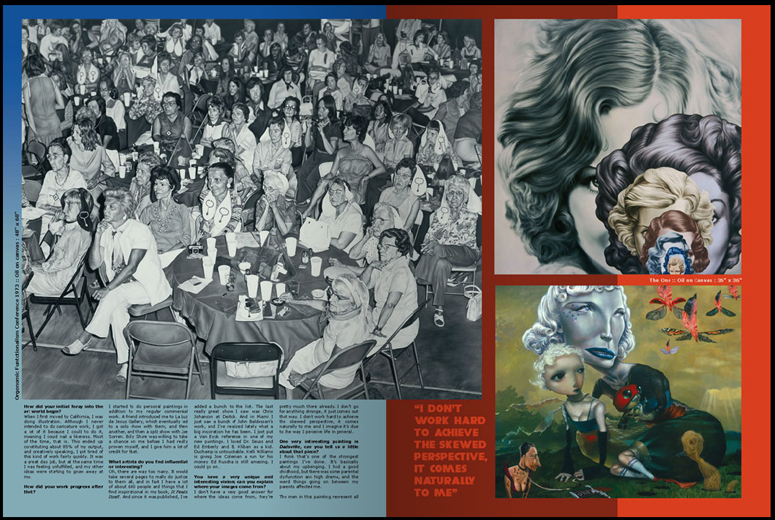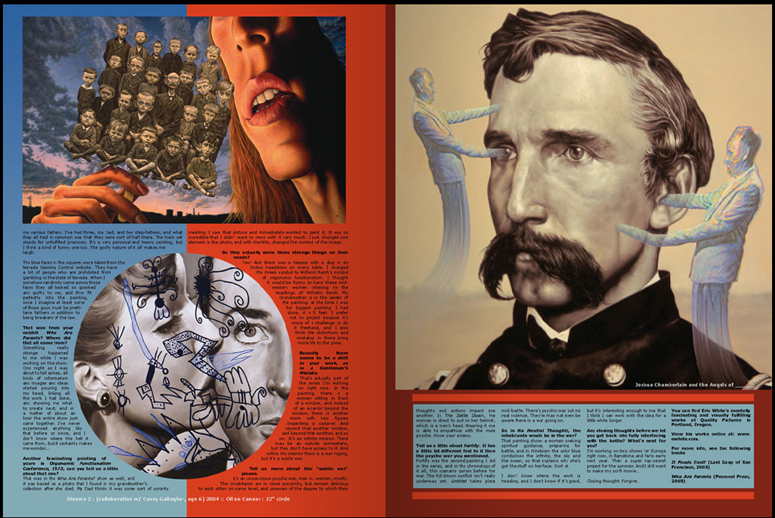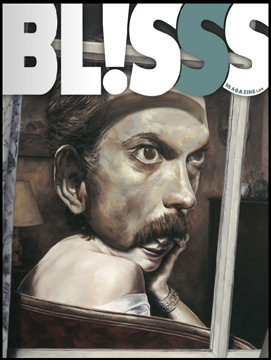



ERIC
WHITE’S INFINITE INTERIORS
Renowned New York artist Eric White lends us a portion of his mind as he paints
and conducts a fascinating interview with Greg Escalante and Nathan Spoor.
GE: So Eric, you’re a New York resident these days but lived
in California for a while. How was the move to New York?
EW: I made the move in 2000. Initially it was awful. For the first year
I was thinking, “I’m going to spend two years here and go to LA.” After
two terrible living situations I found a place to live that I really liked
and started getting more comfortable. I had considered moving to New York
directly after finishing school, but went to San Francisco instead. I think
I would
have been totally overwhelmed and terrified had I come here straight out
of school.
While you lived in San Francisco, you were in Los Angeles quite a bit. You
were getting a lot of attention in LA, so what was it that prompted you to
make the move to NY instead of LA?
Living in San Franscico was great, but after almost a decade I was getting
too comfortable there, and I wanted to make a big change. Most of my shows
were in LA, and I really liked visiting there a lot, and strongly considered
moving there. But, in the end I thought it would be better for me to make the
bigger and scarier move first.
Do you find that you show in New York or Los Angeles more now?
I show more in New York, by virtue of living here I guess. I did a solo
show at Earl McGrath Gallery in 2004, and I’ve been in a bunch of
group shows with some good galleries here, and now and then I still show
in Los
Angeles.
I show with a gallery in Portland, OR, Quality Pictures, and just did a
bunch of new paintings for them for the Aqua Wynwood Fair at Art Basel
in Miami.
Apart from gallery beginnings, where did the actual Eric White begin?
Both my parents grew up in Detroit and met at the University of Michigan, so
I grew up in Ann Arbor. I lived in the same house from age two until I was
eighteen. I went to public school and then went to RISD. My Mom was a nurse
and my Dad was in architecture. I have fond memories of going to visit my Grandfather,
who worked in a Chrysler factory all his life. Every time we would visit he
would be painting, so he was definitely one of my earliest inspirations. I
was always, always drawing, so it was interesting to be around someone that
enjoyed painting as much as I did drawing. I have one of his paintings of a
barn from 1939 in my studio, and I look at it every day.
How did your initial foray into the art world begin?
When I first moved to California, I was doing illustration. Although I never
intended to do caricature work, I got a lot of it because I could to do it,
meaning I could nail a likeness. Most of the time, that is. This ended up constituting
about 85% of my output, and creatively speaking, I got tired of this kind of
work fairly quickly. It was a great day job, but at the same time I was feeling
unfulfilled, and my other ideas were starting to gnaw away at me.
How did your work progress after that?
I started to do personal paintings in addition to my regular commercial work.
A friend introduced me to La Luz de Jesus Gallery, which eventually led to
a solo show with them, and then another, and then a split show with Joe Sorren.
Billy Shire was willing to take a chance on me before I had really proven myself,
and I give him a lot of credit for that.
What artists do you find influential or interesting?
Oh, there are way too many. It would take several pages to really do justice
to them all, and in fact I have a list of about 600 people and things that
I find inspirational in my book It Feeds Itself. And since it was published
I’ve added a bunch to the list. The last really great show I saw was
Chris Johanson at Deitch. And in Miami I just saw a bunch of John Baldessari’s
work, and I’ve realized lately what a big inspiration he has been.
I just put a Van Eyck reference in one of my new paintings. I loved Dr.
Seuss and Ed Emberly and B. Kliban as a kid. Duchamp is untouchable. Kelli
Williams
is giving Joe Coleman a run for his money. Ed Ruscha is still amazing.
I could
go on…
You have a very unique and interesting vision; can you explain where your images
come from?
I don’t have a very good answer for where the ideas come from, they’re
pretty much there already. I don’t go for anything strange, it just comes
out that way. I don’t work hard to achieve the skewed perspective, it
comes naturally to me, and I imagine it’s due to the way I perceive
life in general.
One very interesting painting is Dadsville, can you tell us a little about
that piece?
I think that’s one of the strongest paintings I’ve done. It’s
basically about my upbringing. I had a good childhood, but there was some
parental dysfunction and high drama, and I was affected by the weird things
going on
between my parents.
The men in that painting represent all my various fathers. I’ve had three,
my Dad, and two step-fathers, and what they all had in common was that they
were sort of half there. The train set stands for unfulfilled promises. It’s
a very personal and heavy painting, but I think a kind of funny one too.
The goofy nature of it all makes me laugh.
The blue faces in the squares were taken from the Nevada Gaming Control website.
They have a list of people who are prohibited from gambling in the state of
Nevada. When I somehow randomly came across those faces they all looked so
spooked and guilty to me, and they fit perfectly into the painting, since I
imagine at least some of those guys must be pretty lame fathers in addition
to being breakers of the law.
That was from your exhibit Who Are Parents?, where did that all come from?
Something really strange happened to me while I was working on the show.
One night as I was about to fall asleep, all kinds of information and images
and
ideas started pouring into my head, linking all the work I had done, and
showing me what to create next, and in a matter of about an hour the entire
show just
came together. I’ve never experienced anything like that before or since,
and I don’t know where the hell it came from, but it certainly makes
me wonder...
Another fascinating painting of yours is Orgonomic Functionalism
Conference, 1973, can you tell us a little about that one?
That was in the Who Are Parents? show as well, and it was based on a photo
that I found in my grandmother’s collection after she died. My Dad thinks
it was some sort of sorority meeting. I saw that picture and immediately wanted
to paint it. It was so incredible that I didn’t want to mess with
it very much. I just changed one element in the photo, and with the title,
changed
the context of the image.
So they actually wore those strange things on their heads?
Yes! And there was a teepee with a dog in an Indian headdress on every
table. I changed the Greek symbol to Wilhelm Reich’s symbol of orgonomic functionalism.
I thought it would be funny to have these mid-western women listening to the
teachings of Wilhelm Reich. My Grandmother is in the center of the painting.
At the time it was the biggest painting I had done, 4 x 5 feet. I prefer not
to project because it’s more of a challenge to do it freehand, and
I also think the distortions and mistakes in there bring more life to the
piece.
Recently there seems to be a shift in your work, as in A Gentleman’s
Mistake.
That’s actually part of the series I’m working on right now. In
the painting, there is a woman sitting in front of a window, and instead of
an exterior beyond the window, there is another room with two figures inspecting
a cadaver. And beyond that another window, and beyond that another, and so
on. It’s an infinite interior. There may be an outside somewhere, but
they don’t have access to it. And within the interior there is a war
raging, but it’s a subtle war.
Tell us more about this “subtle war” please.
It’s an unconscious psychic war, men vs. women, mostly. The inhabitants
are in close proximity, but remain oblivious to each other on some level, and
unaware of the degree to which their thoughts and actions impact one another.
In The Settle Down, the woman is about to put on her helmet, which is a man’s
head. Wearing it she is able to empathize with the male psyche. Know your
enemy.
Tell us a little about Fortify. It has a little bit different feel to it than
the psychic war you mentioned.
Fortify was the second painting I did in the series, and in the chronology
of it all, this scenario comes before the war. The full-blown conflict
isn’t
really underway yet. Untitled takes place mid-battle. There’s psychic
war but no real violence. They’re may not even be aware there is
a war going on.
So in No Neutral Thoughts the inhabitants would be in the war?
That painting shows a woman seeking spiritual guidance, preparing for battle,
and in Hinduism t why she’s got the stuff on her face. Sort of.
I don’t know where the work is heading, and I don’t know if it’s
good, but it’s interesting enough to me that I think I can work with
the idea for a little while longer.
Any closing thoughts before we let you get back into fully interfacing
with the battle? What’s next for you?
I’m working on two shows for Europe right now, in Barcelona and Paris
early next year. Then a super top-secret project for the summer. And I
still want to make my sci-fi movie…
Closing thought: Forgive.
You can
find Eric White’s mentally fascinating and visually fulfilling
works at Quality Pictures in Portland, Oregon.
View his works online at: www.ewhite.com.
For more info, see the following books
It Feeds Itself (Last Gasp of San Francisco, 2003)
Who Are Parents (Perceval Press, 2005)

ERIC WHITE'S
INFINITE INTERIORS
Interview by Greg Escalante & Nathan Spoor
BL!SSS Magazine
Vol.3 No.1
To read the article text, scroll down after the article images.